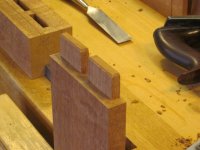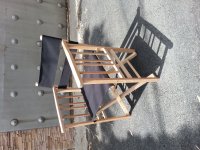I am making some heavy, tropical hardwood doors and am considering using Domino floating tenons. I have a Domino 500 and would like to know if placing more tenons will be strong enough, or if I need the longer tenon of the XL model? I appreciate any feedback. Thanks.
You are using an out of date browser. It may not display this or other websites correctly.
You should upgrade or use an alternative browser.
You should upgrade or use an alternative browser.
Domino 500 versus Domino XL
- Thread starter JacoScott
- Start date
- Joined
- Jan 22, 2007
- Messages
- 8,426
Jaco,
Welcome to the forum.
For the type of door construction you're doing, I wouldn't recommend using the Domino 500. The XL would be the better option due to the longer tenons.
Shane
Welcome to the forum.
For the type of door construction you're doing, I wouldn't recommend using the Domino 500. The XL would be the better option due to the longer tenons.
Shane
I agree with Shane 100%.
Peter
Peter
NiteWalkerGR
Member
- Joined
- May 7, 2014
- Messages
- 192
On the bright side, you have an opportunity to get a new toy. [big grin]
shed9
Member
- Joined
- Mar 22, 2014
- Messages
- 497
NiteWalkerGR said:On the bright side, you have an opportunity to get a new toy. [big grin]
+1, take every chance you get.
The XL is better suited, yes you can use multiples of the 10mm tenons but as Shane states you won't have the depth.
Birdhunter
Member
- Joined
- Jun 16, 2012
- Messages
- 4,145
I just finished a project making 8 Ipe benches. Ipe is an extremely hard wood notorious for not being easy to glue or finish. Having both the 500 and the XL, I decided to go with the longest biggest tenon I could fit into the pieces. Thus, the XL was used. I made my tenons from Sipo stock.
The XL had the power to cut tenons even into the end grain. A cautious feed rate was very critical. Too fast or not perfectly straight in the push, the cutter stopped cold.
I tried both Titebond III and a 2-part epoxy and went with the epoxy with an overnight cure time. I pinned every tenon for extra security. In critical joints, I backed up the tenons with stainless steel screws. The screws were placed to be unseen.
My client wanted to do the finishing with my full agreement. He selected. Cabot stain with UV protection.
My big mistake was that I didn't apply end grain sealer soon enough. I saw two cracks start only a week after cutting the wood. The cracks may have already been in the wood, but applying a sealer immediately after cutting the wood will be my new standard process if I work with Ipe again.
Lots of exotic woods have dangerous dust. Ipe emits a green dust that is very unpleasant. I greatly appreciated the excellent dust collection of the Kapex, TS55, RO125, and Domino XL. Even so, it is important to avoid breathing any of the dust and to shower as soon as you can after being exposed.
The XL had the power to cut tenons even into the end grain. A cautious feed rate was very critical. Too fast or not perfectly straight in the push, the cutter stopped cold.
I tried both Titebond III and a 2-part epoxy and went with the epoxy with an overnight cure time. I pinned every tenon for extra security. In critical joints, I backed up the tenons with stainless steel screws. The screws were placed to be unseen.
My client wanted to do the finishing with my full agreement. He selected. Cabot stain with UV protection.
My big mistake was that I didn't apply end grain sealer soon enough. I saw two cracks start only a week after cutting the wood. The cracks may have already been in the wood, but applying a sealer immediately after cutting the wood will be my new standard process if I work with Ipe again.
Lots of exotic woods have dangerous dust. Ipe emits a green dust that is very unpleasant. I greatly appreciated the excellent dust collection of the Kapex, TS55, RO125, and Domino XL. Even so, it is important to avoid breathing any of the dust and to shower as soon as you can after being exposed.
mouppe
Member
- Joined
- Feb 7, 2010
- Messages
- 3,036
I would not be tempted to use it for the doors you mention. The maximum domino xl tenon length is just under 3 inches per side, however thick you make it up to the 14mm cutter. So the issue for me is not the strength of the joint, but that doors like that should be made with a bridle joint on the rail ends running the full width of the stile- roughly 5 or 6 inches depending on the door. This helps keep the frame in alignment better than a short tenon.
I am sure you could find another reason to buy the domino though!
I am sure you could find another reason to buy the domino though!
What a great Forum! I appreciate all of the feedback.
With bridle joints, they would have to be pinned, right?
The doors are 225cm tall x 92cm wide x 5cm thick and have 12 rails between the stiles. The bottom rail is 7" wide and the top rail 5". The rest are 4-3/8". Between all of the rails are 11 glass panels that are 3" wide.
Two of the doors are fixed and I think with 4 - 6 Domino 500 tenons per rail they should be plenty strong. On the two doors that open and close and have greater stress, do you all think that bridle joints are the way to go?
Or, Could I do longer floating tenons with a plunge router on the top and bottom rails in combination with the Domino 500 tenons, and then do the 10 other rails with just the Domino 500? Or, do you think doors this heavy need the longer tenon everywhere?
Thanks.
With bridle joints, they would have to be pinned, right?
The doors are 225cm tall x 92cm wide x 5cm thick and have 12 rails between the stiles. The bottom rail is 7" wide and the top rail 5". The rest are 4-3/8". Between all of the rails are 11 glass panels that are 3" wide.
Two of the doors are fixed and I think with 4 - 6 Domino 500 tenons per rail they should be plenty strong. On the two doors that open and close and have greater stress, do you all think that bridle joints are the way to go?
Or, Could I do longer floating tenons with a plunge router on the top and bottom rails in combination with the Domino 500 tenons, and then do the 10 other rails with just the Domino 500? Or, do you think doors this heavy need the longer tenon everywhere?
Thanks.
wrightwoodwork
Member
- Joined
- Jul 1, 2013
- Messages
- 410
I personally wouldn't bother with a bridle joint as in my opinion it will take out too much in the stiles for the mortises. The rule of thumb is that the tenon should be no more than 5 times it's thickness or something like that can't remember 100%. If you want to go down that route I would consider mortise and tenon. To aid making the mortises you could still use the xl then change the depth at the haunches. Then use the domino xl to produce the through mortise. For the tenons. I would line up the rail and with the aid of the guide rail and router make the tenons. Then where the haunches are to be cut I would use the waste to make my wedge s. Do you know anyone with a domino xl you could use to make a couple of test joints. If using the domino I would properly have 1 inch to 1 1/2 between
3R PROJECT
Member
- Joined
- Jun 13, 2014
- Messages
- 28
Domino XL for hard wood and never look back . I made 1200 mortise holes with a d10 on 2inch thick beech that I had to jig all the way through . Although the tool didn't have any rest time it never got hot besides the its metal parts . In significantly though and understandably considering the torture . It made my 4hp three phase industrial reciprocating jig look like a toy . Effortless , plus you dont have to move left and right in samba mode like on the Casadei l'artigiana and way faster . I never though a hand tool could ever measure up to a professional machine .
Birdhunter
Member
- Joined
- Jun 16, 2012
- Messages
- 4,145
What is a d10?
Birdhunter said:What is a d10?
I'd guess it is shorthand for 10mm domino. Though I'd usually interpret it as 10 diameter.
3R PROJECT
Member
- Joined
- Jun 13, 2014
- Messages
- 28
That is how Festool calls the 10mm diameter domino jig . Diameter 10mm = Dia 10mm = D10 mm= a circle with a line going through it diagonally followed by the dimension . In festool's domino case D followed by the size in mm inducates the size of the jig . Hence , d10 d12 and etc .
Birdhunter
Member
- Joined
- Jun 16, 2012
- Messages
- 4,145
I understand a 10mm Domino bit, but I don't understand the "jig" part. In the US, a "jig" is a fixture usually built for a specific function to provide accuracy and repeatability. Another definition of a "jig" is a dance.
I'm just curious.
I'm just curious.
3R PROJECT
Member
- Joined
- Jun 13, 2014
- Messages
- 28
You are correct . Jig bit . I am sorry for the confusion .
3R PROJECT
Member
- Joined
- Jun 13, 2014
- Messages
- 28
My point is . That my stationary jig with a short d10 triple bit can handle only one of the beech horizontal inch thick beams of this chair and with effort . The domino can handle two of them together , effortless and three times faster . When you are making 200 of this chairs , that means money . I hope this helps . Again I am sorry for the mistake , English is not my first language .
Attachments
Birdhunter
Member
- Joined
- Jun 16, 2012
- Messages
- 4,145
Thanks for the "bit/jig" clarification. Your English is very good. I used to travel often Internationally and was fascinated with the different words used to describe the same thing around the Globe.
Similar threads
- Replies
- 5
- Views
- 88
- Replies
- 11
- Views
- 1K
- Replies
- 0
- Views
- 252
- Replies
- 10
- Views
- 1K


